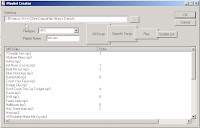
I haven't gotten much sleep this weekend... so on to another project! I've written some PC software - to use the Wiimote controller in 2 PC games. The Wiimote library I'm using is very well done and useful... written by Brian Peek and found here: http://www.codeplex.com/WiimoteLib
To use the software and Wiimote, you really only need a Wii Sensor Bar and/or a separate IR LED for a point source. Johnny Chung Lee and many others have some really COOL stuff out there - I suggest checking out Johnny's website and things he has done to get you thinking... http://johnnylee.net/projects/wii/

So, I built a quick Sensor Bar to attach to my laptop and powered off of a USB port. Just 4 IR LEDs, 4 resistors (4.7K Ohms), an old cable, and a plastic 'bar'. Total cost was ~$0.60 and it took about 0.5 hours. (You can tell by the 'gorilla' soldering that it ain't pretty, but it works).
Here is the final IR LED Sensor Bar, with each pair of IR LEDs spaced out 7.5 inches apart. Here is a better example to use as a reference: http://johnnylee.net/projects/wii/
Results were poor. The IR LEDs output is fairly low compared with alot of the background light from the display, etc. So... i moved on with a different approach.

I have a bunch of coin (quarter) size 3.0V batteries and holders I got years ago for a different LED project (NWPodcast #76 - Salmon Fishing LEDs) and decided to rig up 2 of them with IR LEDs that I could then stick on the top of my PC (using Silly Putty!) to make it more mobile and easy to position.
Here are the coin batteries with IR LEDs soldered directly to their leads. Very easy to use and fast - just pop in the battery and you are good to go.
The final result resting on my laptop keyboard (the kids were gone and someone took Dad's Silly Putty and didn't put it BACK!) Works better than the Sensor Bar design, and easier to use. Now to finish the games and use the hardware...






















